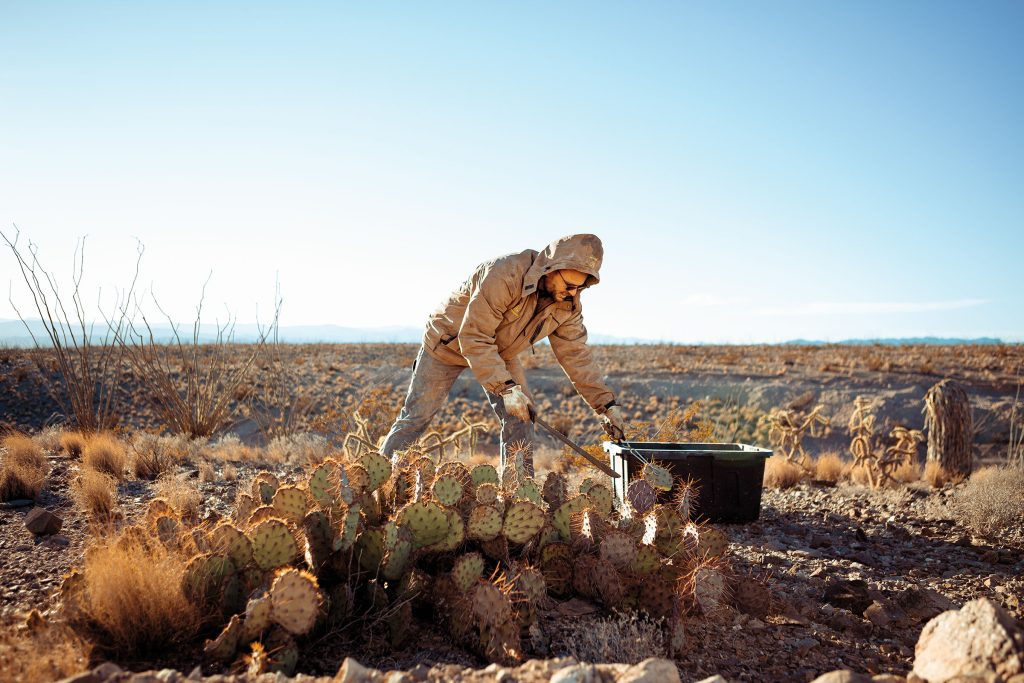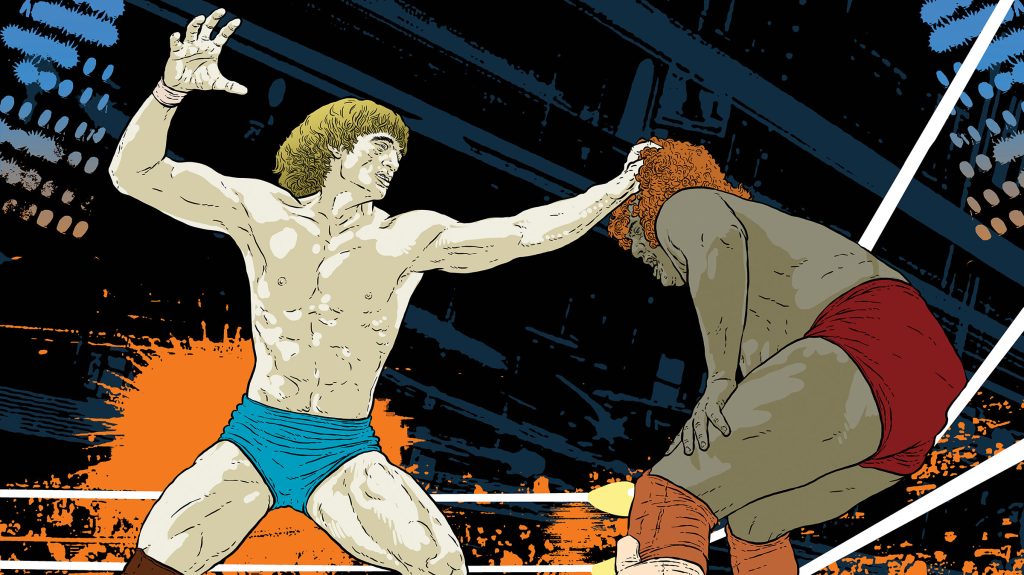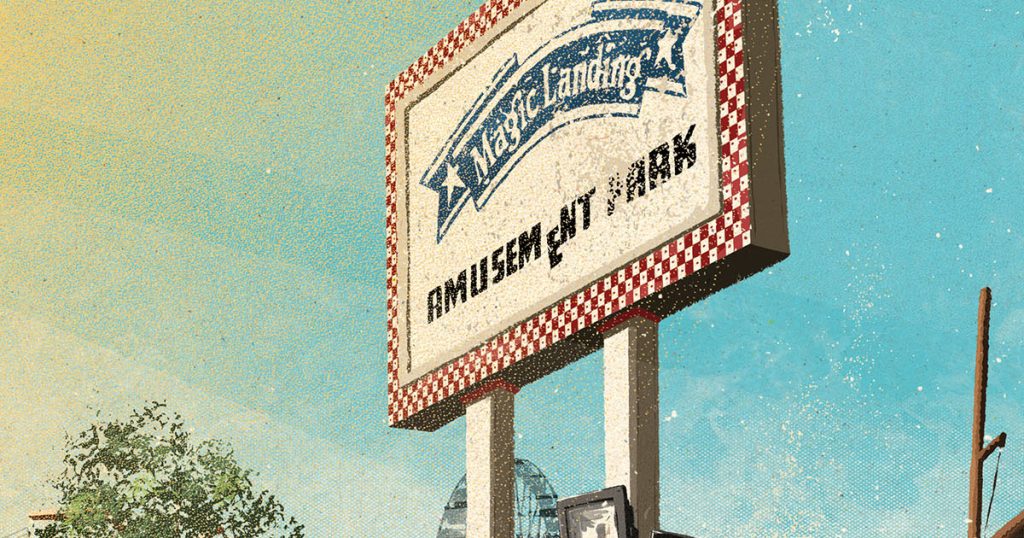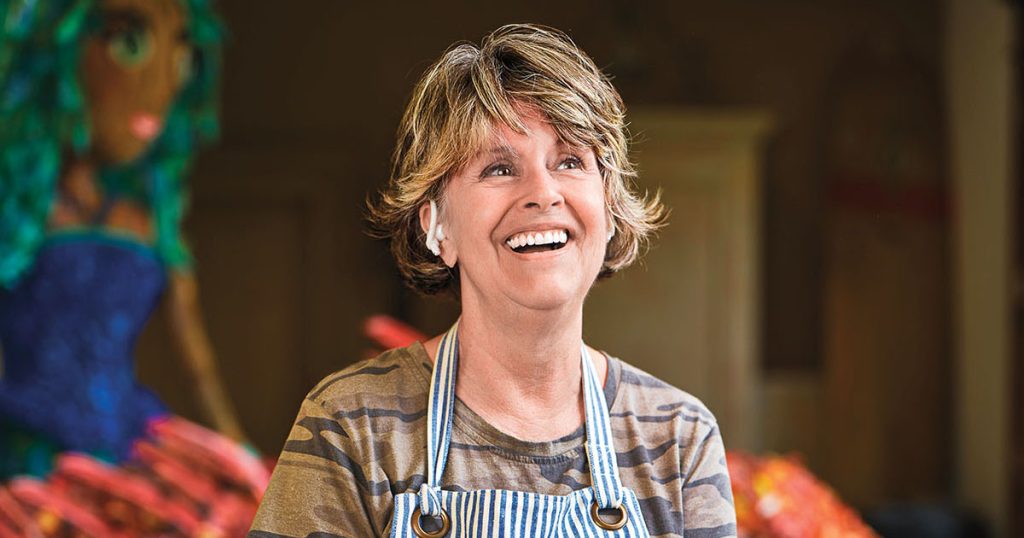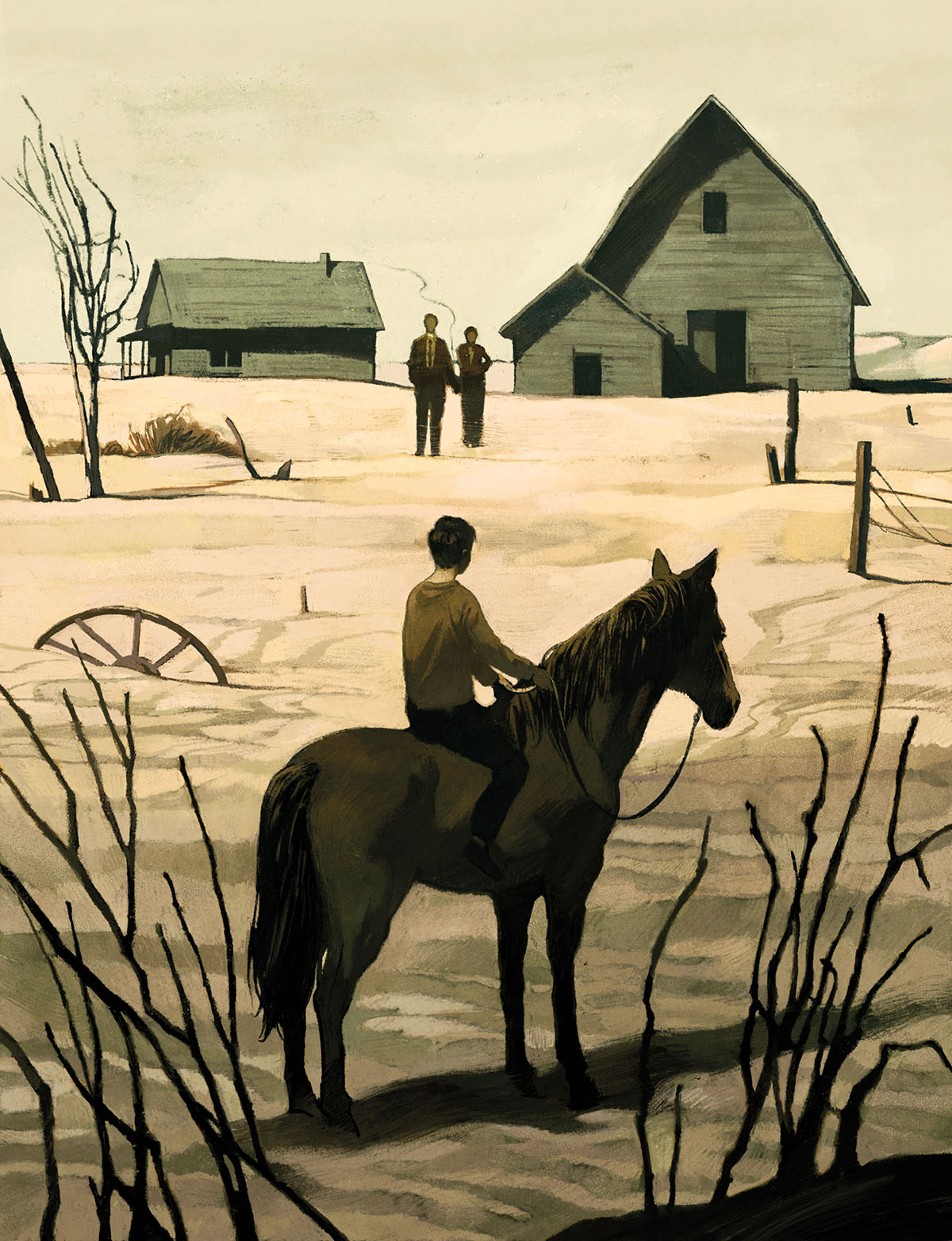
Getaway Driver
A grandpa’s tall tale sends a Panhandle native back to the scene of the crime
by Lauren Hough
This is already one of my favorite museums, and I’ve been to my share—in London and Berlin and Osaka and Rome and Cairo, and to the Panhandle-Plains Historical Museum down the road in Canyon. It’s always irked me when other tourists show up on the day I visit to block my view and laugh inappropriately and talk too loudly. It’s not that I think I’m special and should be allowed to wander freely, unperturbed by tourists. No. It’s exactly that. I enjoy history. I’m here to learn. They’re here to take a few selfies for Instagram. I should have the place to myself.
So, when Raquel Riggs, the curator of the Pioneer West Museum, gave me a quick briefing on the place and left me to explore, I couldn’t believe my luck. I was finally touring a museum the way I’d always intended—alone. The museum is housed in the Reynolds Hotel, a stately brick Mission Revival structure built in the 1920s, during the oil and railroad boom, and named after local attorney Marion Reynolds. Each of the 25 rooms in the museum focuses on a different subject or era—fossils and arrows; barbed wire and the railroad; the pride of Wheeler, astronaut Alan Bean, the fourth man on the moon—with every conceivable surface chock-full of artifacts. There’s a fort, a chapel, a barbershop, a general store, a dental office. Hard to believe they’ve fit this much into one little hotel on what used to be a main street.
According to Raquel, everything in the museum was donated by locals. From what I can tell when I get up to the second floor, someone in town had a habit of collecting dolls that bordered on the maniacal. I’m so discombobulated by the dolls—yellow hair in ringlets and complicated braids, hoop skirts, velvet coats, tiny white aprons, delicately painted bow lips and blush, and eyes that follow you—I’ve forgotten why I’m here. I hope they host a haunted house in October.
Downstairs, in a hallway, are the framed newspaper clippings to remind me why I’m here—Bonnie and Clyde and Grandpa Chuck. My grandpa, thankfully, isn’t mentioned in the clippings. He wouldn’t be. From what I can tell, if his story’s true, he was just a little kid.
My grandpa has always dressed like a farmer. He favors overalls or Wranglers strung up by suspenders, pearl-snap shirts, boots, and a short-brim Stetson. When he went to church or dinner, he’d wear what he called his “uptown” suspenders, slimmer and printed with paisley or little flowers. When I was little, he smelled like pipe tobacco, and he’d blow smoke rings for me to slap apart before they floated to the ceiling. That smell has always reminded me of him. There were years I didn’t know him at all—divorce and remarriage, different states and countries. I didn’t know, for example, he was from Texas, not Denver, where he lived in a split-level and ran his own barbershop. I didn’t know, until recently, that he’s always wanted to rob a bank.
When my grandpa needed some extra help, he moved in with my dad here in Austin. When I moved to Austin, five years ago, I’d watch him in the afternoons so my dad could run errands. He didn’t always know who I was. Alzheimer’s is a hell of a disease. But I noticed if I got him talking about the old days, his mind was sharp and full of stories. I’d pour him a Lone Star and every time, like a ritual, he’d ask me if I was interested in robbing a bank. I told him I could be the getaway driver. He said, no—he’s driving. My grandpa’s legally blind. I picture us making a getaway at 12 miles per hour. He told me we needed one more guy. “Let’s go tomorrow,” he said.
At first, I thought he was kidding about the whole bank-robbing thing. But I asked, once, if he was serious. We were sitting on the porch, watching the dogs wrestle, drinking the beer I’d snuck in for him. My dad doesn’t like him to have too many—bad for his cholesterol. I think being in his 90s is probably bad for his cholesterol. So, I sneak him a beer on occasion. He’s earned it. That afternoon, I asked him if he was kidding about robbing a bank. He wiped the condensation off his glass then used it to flatten his wispy hair. He said, “Oh, no. I’m serious as judge. And they’ve got it coming. They took my horse.”
I asked, “The bank?”
He said that was back in Texola. He mixes up town names occasionally. Sometimes he tells me Shamrock is where he had the horse. I do know, in the mid-1930s, the bank took the ranch in Shamrock and his family moved to Texola, just across the Oklahoma border, on what’s now Interstate 40.
I’d been asking him about the Dust Bowl, an obsession of mine. I like writing Dust Bowl stories, and he lived through it. That my grandparents survived it and told these stories when I was a kid may be the root of my obsession. We had to listen to the stories until someone told us to go play outside, but don’t get dirty. I was always only half listening back then. Now, stories need detail, and my grandpa has all the details—how to catch a bunny for dinner by jabbing a strand of unraveled barbed wire in the hole, how his job was to herd the chickens into the house to ride out a duster, how his mom papered the walls with newspaper in a desperate attempt to keep the dust out.
He’d often wind up talking about his horse named Eagle he rode to school. When school got out, Eagle would be waiting for him. Didn’t even have to tie him up. But until that afternoon in 2018, he’d never mentioned the bank. He said they took the farm, and maybe they had a right. But they had no right to take his horse.
I thought that was it for a moment. Stories end like that sometimes, drift into nothing, and he’ll ask about supper. But my grandpa grabbed a tissue from his chest pocket, and I saw he was crying. He said there wasn’t anything they could do. The bank took the farm, and then they took his horse. They had no right. “Never trust a bank,” he said.
I wanted to change the subject. I’d never seen my grandpa cry. I asked about Shamrock, and he said, “Bonnie and Clyde.” Like he’d been trying to remember the name of an actor. But we hadn’t been talking about movies.
“What?” I asked.
“Bonnie and Clyde. They were hiding in the barn.”
“Bonnie and Clyde?”
He laughed and I knew he was well aware of the bomb he’d dropped. I asked, “Oh, they were bank robbers, right?” I was trying to remember what I knew about Bonnie and Clyde and came up with, I think Warren Beatty was in the movie.
He said, “They robbed banks, all right. Were pretty good at it, too.”
I thought, well, at least we’re not talking about the horse now. Maybe this was a story he’d heard. Then he added, “They gave me a box of chocolate bars.”
I nearly spit my beer. He laughed and took another sip of his and said it again. “Bonnie and Clyde.” I waited. He was enjoying this.
“They were hiding in the barn,” he said. He was looking off into the middle distance like he could see the barn now.
“Bonnie and Clyde?”
“Yep, I brought them their supper,” he said. “I was only 7 at the time.”
I waited for him to continue, but when he didn’t, I asked, “And they gave you a candy bar?”
That perked him up. “No, a whole box of candy bars. Chocolate bars. Hershey’s. A whole box,” he repeated. “Like this.” And he held out his hands and formed a shoebox. He added, “My older brother—and this was really his deal—he showed them a way out of town, to avoid the sheriff.”
And that was it. I asked him again and recorded part of it on my phone. I don’t know why. I think now I just wanted proof.
When my dad got home and I told him the story, he said, “No, that was Dillinger.” Like this was a story he’d heard a million times as a boy and hadn’t thought about since. He was sure it was Dillinger. I told him, “Dillinger was Chicago, Dad.” He shrugged and said maybe he mixed it up. This was driving me nuts. I Googled “Bonnie and Clyde Shamrock” on my phone. All I could find was some info about a chase that ended with their car in the Red River and some locals helping them. The write-up said someone was shot.
My dad said that didn’t sound right, that my grandpa would’ve mentioned the river or someone getting shot. He said he was pretty sure it was Dillinger anyway. I didn’t show him the Wiki page for Dillinger.
My grandpa’s older now than he was then—that’s how aging works. He still enjoys a beer, but he doesn’t know who I am. He no longer tells stories. All I’ve got is what he told me on those summer afternoons. Maybe that’s why I got it into my head to drive up to Shamrock and find out if his story was real.
The drive from the Hill Country to the Panhandle might be one of those drives one can enjoy only if they’re from the Panhandle. And I am—Amarillo. Which is to say, when the road flattens and widens, when the mesquite-dotted hills are replaced by flat brown fields of prairie grass, when the dirt turns red and the sky never ends and I swear I can see all the way to Colorado, I’m someone who’ll pull over at the first Allsup’s and fill a vat with Dr Pepper and order two burritos—yes, please, to the offer of hot sauce. It’s a strange thing, driving up this edge of Texas—the High Plains and the Llano Estacado to the left, the canyons and the hills to the right, through one-street towns of close-built shops, many boarded up nowadays. I can still picture horses tied to the rails out front.
Outside the museum, Raquel asks me what I’m writing about. I tell her my grandpa’s story, the main points anyway. She asks his name and says she doesn’t know any Houghs around here. The old-timers chime in—don’t know any Houghs. I say my grandpa’s people weren’t here long. They moved to Texola when the bank took the ranch. The old-timers say that’s how it often happened. I think my grandpa’s probably not the only one with a grudge against banks. Raquel asks if I’ve been to the U-Drop Inn.
If you Google “Shamrock, Texas,” the Conoco Tower of the U-Drop Inn is the image you’ll see, and for good reason. It’s a beautifully preserved art deco building. If you wait in front of the tower longer than a minute, you’ll see tourists get out of their cars and stand long enough to make sure their legs still work after hours in the car—that sprint from Oklahoma City or Albuquerque, maybe Amarillo if they allowed themselves the rest. They take a couple pictures, check their screens, take a couple more. The tower’s turquoise neon looks amazing on Instagram. This part of Shamrock, the road that used to be Route 66, still looks like 1955. The drive-up motels and auto repair shops. The hand-painted signs scrubbed dull by the wind. The ancient Chevies and Fords still glistening, polished by those who treasure these artifacts of the time before I-40 bypassed the town. The tourists take their photos then drive away.
The smart ones go inside before they hit the road again. Inside the U-Drop Inn, you’ll find an info center in the large lobby of the old gas station—the shelves now lined with pamphlets, books, and local art. Through a door to the right, a small café. At the U-Drop, you get to meet Hazel and Oleta.
Oleta Stone looks so familiar you’re sure she’s a distant aunt you met at a family barbecue a few years ago. You just can’t quite place if she’s on your dad’s side or your mom’s. She’s warm like that. Like she knows you might be a little uncomfortable meeting all these new people, and she’ll fix you a plate and introduce you to some cousins who’ll play with you.
When I arrive at the U-Drop, Oleta’s showing a couple tourists a mural on the back wall of the Pixar movie Cars. She’s telling them how the scenery and buildings were all real places on Route 66. I wander around looking at hats, T-shirts, a mannequin of a sheriff with handcuffs on his hip. The tourists leave, and Oleta asks if I need any help. I tell her I’m working on a story about my grandpa and ask about Bonnie and Clyde. She says I ought to check out the museum. She assures me Raquel will welcome me. I say I’ve been, and she says if I want to know more, I really should talk to Hazel.
Hazel Janssen’s at the register and rings me up for a couple Route 66 bumper stickers. Oleta tells Hazel I’m a writer, and I swear I can hear the pride in her voice. Hazel’s proud of me, too. I want to stay awhile and soak up all this warmth. Maybe I miss my grandmothers. Hazel asks why I’m interested in Bonnie and Clyde, and I say I’m not really. I tell her about my grandpa. I tell her about my grandparents and how they survived the Dust Bowl and used to tell me stories. That the Dust Bowl—this disaster no one talks about—is an obsession of mine. For nearly 10 years, most of the 1930s, the entire middle of the country looked like the Sahara Desert. And anytime I mention it, all I get is a blank stare. Hazel says she was born in ’35, the middle of the worst of it. Her mom used to cover her crib with a wet sheet so she wouldn’t choke on the dust. I say this is what I mean. These details. We hear about those who left. We never hear from those who stayed. And people did stay. She locks eyes with me and says, “Some people couldn’t afford to leave.”
Hazel says she knew the lady Clyde shot. Her name was Gladys Cartwright. The Cartwrights and another family, the Pritchards, had seen the Barrow gang’s car go into the Red River. The Pritchard and Cartwright men rescued the passengers from the sinking car—two men and a woman. Clyde and his brother, Buck, were all right. Bonnie suffered burns to her leg. They all wound up at the Pritchard farmhouse, where the gang held the families hostage while they treated Bonnie’s wounds. Gladys, only 19 at the time and holding an infant in her arms, had reached for something above a cabinet, and seeing a threat, Clyde shot her hand. A newspaper clipping from the time says Buck shot her. In any case, her hand took a load.
Hazel says Gladys used to play piano, was pretty good at it, too. The gang’s car is still there, under the river, swallowed by the quicksand. But Gladys never played piano again.
I tell her I’m pretty sure that wasn’t my family. All my grandpa said was they were hiding in the barn. Hazel says it’s likely. The Barrow gang was all over town for a time. They even ate in the café next door.
“I’m not sure I’ll ever know if it’s true,” I say of my grandpa’s tale. “Why wouldn’t it be true?” Hazel responds. “It’s his story.” I agree and say maybe I just wanted to honor a little part of his past. He’s my last grandparent. I wonder now how many other stories I’ve lost.
I resist the urge to hug them when I leave.
Next door, at the café, I order a cheesecake and a bottle of Coke. I’ll regret the sugar crash later, but I can’t resist a bottled Coke. The place is so well preserved—a low café bar lined with short chrome stools, an ornate tin ceiling, soft pleather booths under the windows—you’d think they wrapped it in plastic 70 years ago and just unwrapped it last night. The story goes, Clyde asked the waitress here about a slot machine. She told him it was just emptied, in case he was thinking of robbing it. They bought lunch and paid. I wonder which booth they sat in. I wonder how my grandpa’s family escaped unscathed so the only story he’s got is about a box of candy bars, while a few miles down the road, a woman who played piano never got to play again.
I’d never been off the highway in Shamrock. But I have a video of my grandpa telling me a story about Bonnie and Clyde. I thought this essay would be a fun way to check out the town and find out more. Turns out, I found a way to honor my grandpa. Charles Hough was born in 1927. He died in Austin on Jan. 14, while I was finishing this story. And I believe every word of it.
